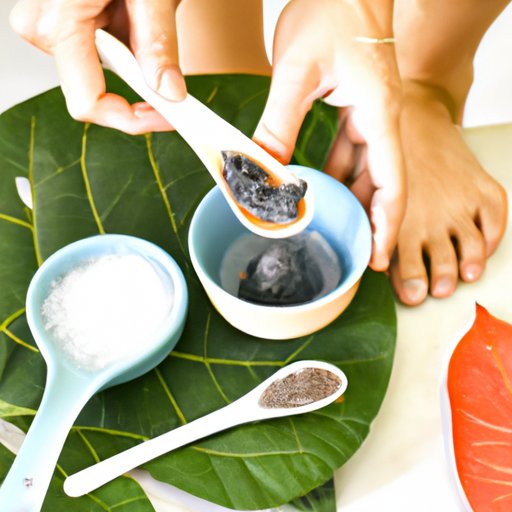
Introduction
Exfoliating your legs is an essential part of any beauty routine. It not only helps to remove dead skin cells, but also leaves your legs feeling smooth and looking healthy. In this article, we’ll explore the benefits of exfoliating your legs, provide expert tips, and share easy-to-follow DIY scrub recipes for silky legs.
Tips for the Perfect Leg Exfoliation Routine
The most effective way to exfoliate your legs is to establish a routine and stick to it. We recommend exfoliating your legs once or twice a week, depending on your skin type and individual needs. Before starting, it’s important to ensure that your skin is clean and dry.
First, apply an exfoliating scrub in circular motions, focusing on areas with rougher skin such as your knees and ankles. Rinse off with warm water and pat dry. Follow up with a moisturizer to help lock in the newly revealed softness and help soothe any irritation. For optimal results, avoid shaving your legs right before exfoliating. Instead, either shave the day before or wait until after you’ve exfoliated.
The Benefits of Exfoliating Your Legs and How to Do It Correctly
Exfoliating your legs has many benefits. Not only does it remove dead skin cells, but it can also help to unclog pores, prevent ingrown hairs, and improve circulation. To exfoliate your legs correctly, start by choosing an exfoliating scrub that suits your skin type. Be sure to avoid using scrubs that are too abrasive as they can damage the skin.
When applying the scrub, use gentle pressure and massage the skin in circular motions, starting from your ankles and working your way up. Avoid scrubbing too hard or for too long, as this can lead to irritation and damage to the skin. After rinsing off the scrub, be sure to moisturize your legs to help lock in moisture and protect your skin.
Homemade Exfoliating Scrubs for Smooth and Silky Legs
You don’t need to spend a lot of money on exfoliating scrubs as you can easily make your own using common household items and natural ingredients. Here are some easy DIY recipes:
-
Brown sugar scrub: mix brown sugar, honey, and coconut oil to create a gentle scrub that smells amazing.
-
Coffee scrub: mix coffee grounds, sugar, and olive oil to create a caffeinated scrub that helps to reduce the appearance of cellulite.
-
Baking soda scrub: mix baking soda, water, and a few drops of essential oil to create a gentle scrub that’s perfect for sensitive skin.
Not only are these DIY scrubs easy to make, but they’re also extremely nourishing for your skin. The natural ingredients can help to soothe, hydrate, and protect your skin.
The Do’s and Don’ts of Exfoliating Your Legs, According to Dermatologists
It’s important to exfoliate your legs correctly to avoid any damage to the skin. Here are some do’s and don’ts to keep in mind, according to dermatologists:
-
Do exfoliate your legs regularly, but no more than twice a week.
-
Don’t use scrubs that are too abrasive as they can damage the skin.
-
Do moisturize your legs after exfoliating to help lock in moisture and soothe irritated skin.
-
Don’t exfoliate right after shaving, wait a day or exfoliate before you shave.
By following these expert tips, you can ensure that your exfoliation routine is safe and effective.
How Often Should You Exfoliate Your Legs and What Products to Use for Optimal Results
How often you should be exfoliating your legs depends on your skin type and individual needs. If you have dry or sensitive skin, exfoliating once a week may be sufficient. If you have oilier or rougher skin, you may benefit from exfoliating twice a week.
When choosing exfoliating products, consider your skin type and any specific concerns you have. Physical exfoliants, like scrubs, work well for most skin types, but chemical exfoliants, like glycolic acid or salicylic acid, can be more effective for oily or acne-prone skin. Be sure to patch test any new products to avoid any allergic reactions.
Conclusion
Exfoliating your legs is an important part of any beauty routine. By following the guidelines provided in this article, you can ensure that your leg exfoliation routine is safe, effective, and leaves your legs feeling smooth and looking healthy. Remember to take care of your skin by moisturizing regularly and not over-exfoliating.




